Learn how to easily create and maintain a gluten free sourdough starter for delicious gluten free sourdough breads and other baked goods without gluten. Here is how to make the best gluten free sourdough starter.
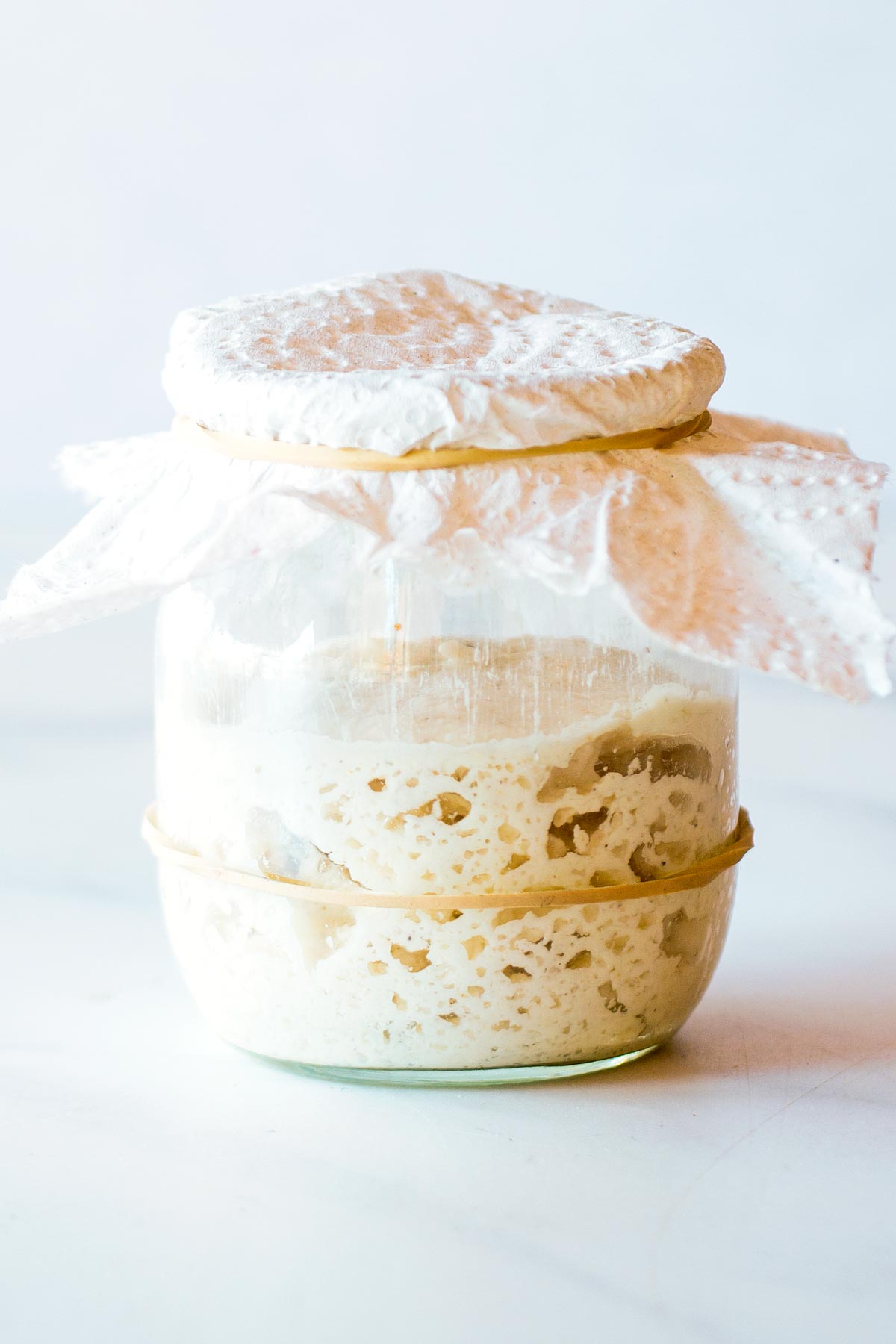
What is Gluten-Free Sourdough Starter?
Many know of sourdough bread, which often comprises flour, water, salt, and a sourdough starter. The purpose of the sourdough starter is to add flavour to whatever you add it to, as well as help your baked goods rise.
It acts as a replacement to store bought yeast, relying instead on the development of wild yeast and bacteria that can offer both flavour and structure to baked goods.
A traditional sourdough starter is a mixture of flour and water that contains yeast and can help leaven bread dough. However, if you are someone who prefers to eat gluten-free bread, you will require a sourdough starter that does not contain wheat-based flour.
This is where this gluten-free sourdough starter recipe comes in. Rather than including all-purpose flour, whole wheat flour, or rye flour, it utilizes a gluten-free flour blend instead.
To keep things easy and uncomplicated like to use ready-mixed Bob's Red Mill 1 to 1 blend but there are many different types of gluten-free flour you can choose from. Just make sure it is a full blend of flour that is created to replace wheat flour in an equal ratio.
Typically these blends contain a combination of gf flours like brown rice flour, white rice flour, coconut flour, teff flour, potato starch and others. Additionally, the blend mixture should also contain xanthan gum, in order to mimic the missing gluten.
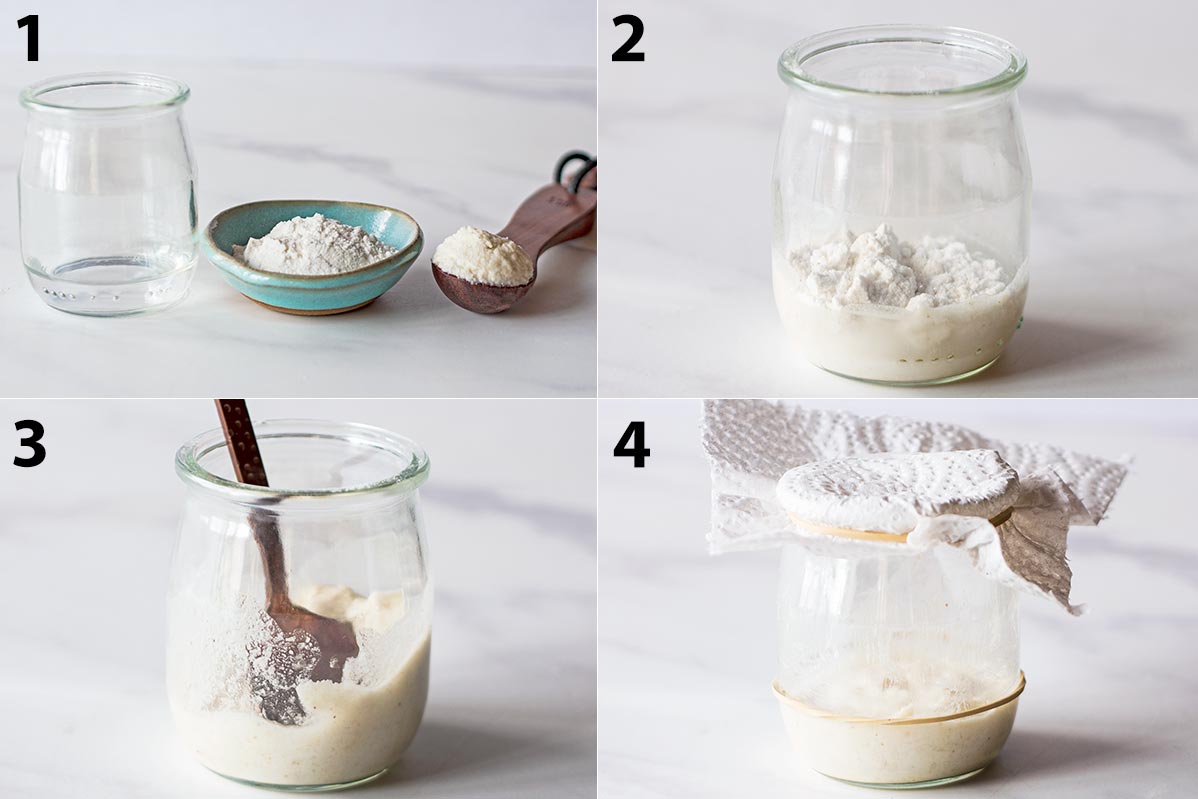
How to Make Gluten-Free Sourdough Bread Starter
The process of making and feeding gf sourdough starter is similar to wheat-based versions.
1. Ingredients needed are just gluten free flour and water + some starter from the previous feeding (not Day 1). Some filtered water is best as the chlorine in tap water may inhibit the fermentation process of your starter.
2. On Day 1, you simply add 10 grams of your chosen gluten-free flour with 10 grams of water in a glass jar.
3. Stir together until the liquid and dry ingredients are well combined and have a uniform, smooth consistency.
4. Cover it loosely with a paper towel for a lid fastened with a rubber band or the band of the jar. You should also place an elastic around the jar at where the top of the mixture sits so that you can see whether the mixture rises or not, and how much. You can also mark the line with a marker. Then, you allow the mixture to sit on the counter at room temperature until Day 2.
Then, on Day 2, you add another 10 grams each of gf flour and water to the jar before allowing it to sit at room temperature for another day.
On Day 3, the starter might have risen above the elastic band and have some bubbles, showing its activity. At this point, you should discard half of the sourdough starter from the jar and feed the mixture with another 10 g of water and 10 g of flour.
The Day 3 process continues for Days 4 to 14, or until the starter doubles in size within about six hours. Then, you will know that your starter is active enough to bake with.
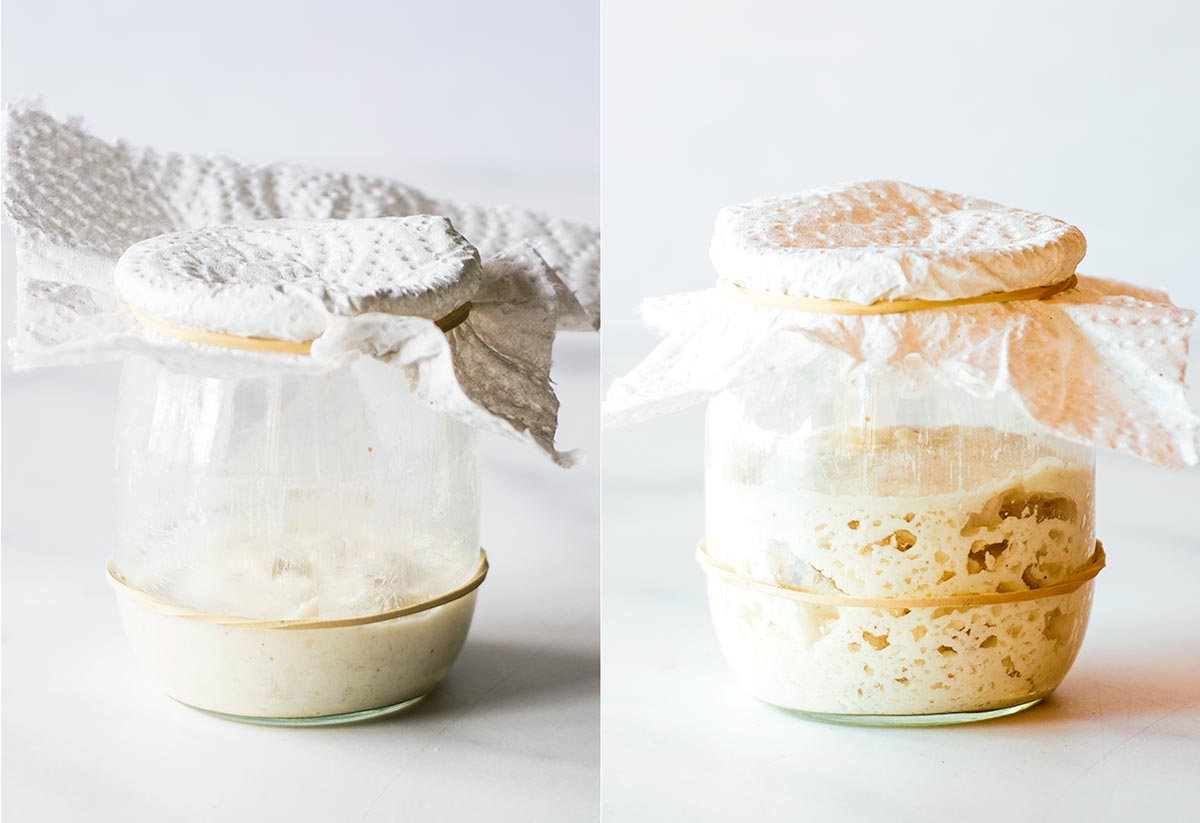
When is Gluten Free Sourdough Starter Ready?
As mentioned above, an active sourdough starter has bubbles and increases in size, doubling within a six-hour time frame. However, there is another way to test whether it is ready to use in your baking recipes or not.
For this method, simply drop a small portion of the starter in a glass or water. If it floats, it has reached the correct level of activity to bake with, whereas, if it sinks to the bottom of the glass, it needs more time.
Maintaining a Gluten Free Starter
Frequent sourdough bakers just keep their starter on the counter and feed it daily. But if you are like me, and only bake sourdough about once a week, there is no need to maintain such a rigorous feeding schedule - just a little planning in advance.
I simply store the starter in the fridge, covered with an airtight lid. Then, as baking day advances, I remove the starter from the refrigerator about 2 days before. Let it come to room temperature, and then start feeding it as outlined above. Within 1-2 feeds the starter should be back to normal, bubbly activity.
Even, if you are not baking weekly, I recommend feeding the starter weekly, so that it stays relatively active and you can revive it quickly. If you are taking a longer break from sourdough baking, you can leave it to stay dormant for longer. Just keep in mind that it will also take longer (more feedings) to get the starter to become active again.
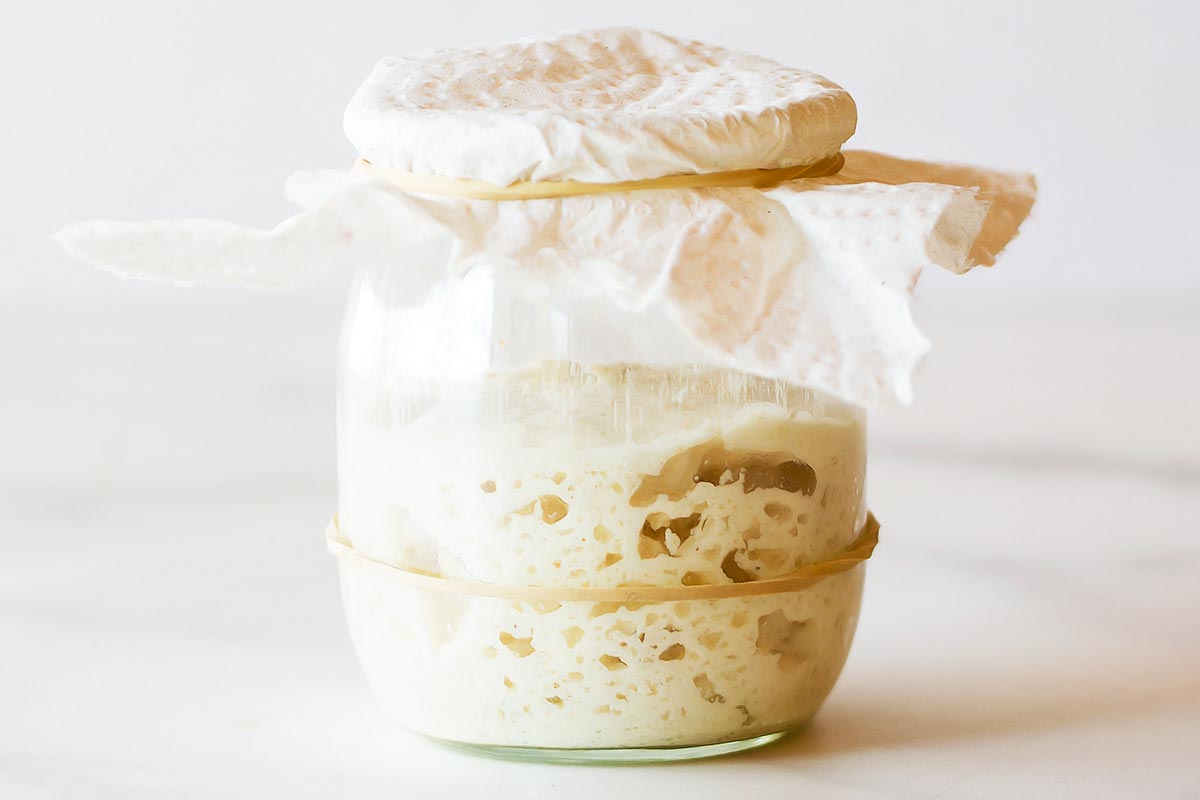
How to Use Sourdough Discard
As you are feeding your starter daily, you will be removing a lot of it. This part that gets removes is called discard. But by no means do you have to throw it out.
Just collect it all in a 'discard jar' and use in any of your baking that could benefit from a sourdough flavour. Some ideas include pancakes, waffles, scones, pizza crust, muffins, and breads.
You can look for a dedicated gluten free sourdough dough discard recipe, or do the calculation yourself. Since starter is equal parts water and flour, you can weigh your discard (say it's 100 grams), then divide the total by 2 (100/2=50). Now subtract that number (50g) from the water and flour amounts called for in the recipe.
How to Use GF Sourdough Starter
Once you have your gf starter ready, you will want to use it in all of your favourite recipes, including my favourite easy gluten free sourdough bread recipe. The classic way of using a homemade sourdough starter would be to make a sourdough loaf of bread, but there are several other ways you can use it as well.
While many think of sourdough as a bread, the term actually refers to the use of a developed starter rather than store bought yeast. As a result, sourdough starter actually has a multitude of uses. Here are some of them:
- In fluffy sourdough biscuit recipes
- As a part of homemade waffles for a slightly sour kick
- In bagels with your favourite garnishes such as sesame seeds or everything bagel mix
- As the leavener in coffee cakes with streusel toppings
- In cinnamon bun or sticky bun recipes
More Gluten-Free Recipes You'll Love:
- Coconut Flour Blueberry Muffins
- Coconut Flour Scones
- Pumpkin Oatmeal Cookie in a Mug
- 17+ Best Gluten Free Cookies
Recipe
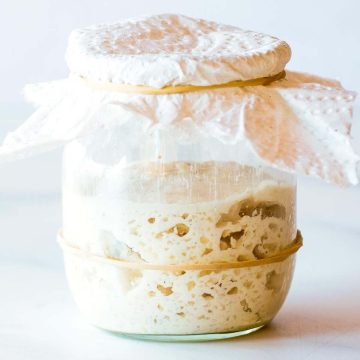
Gluten Free Sourdough Starter
Equipment
- small jar
- lid
- rubber band
Ingredients
- 70 g gluten free flour blend *
- 70 g filtered water
Instructions
Day 1
- In the small jar stir together 10g gf flour (1.5 tablespoons) and 10g water (2 teaspoons). Scrape down the sides of the jar and place a rubber band at dough level. Loosely cover with a lid or paper towel attached with a rubber band.
Day 2
- Add 10g of gluten free flour and 10g of water and stir everything together. Scrape down the sides and move the rubber band up to the fill line. Cover loosely.
Day 3
- Now you may already see the starter has risen a little above the fill line marked with the rubber band. Remove about half of the mixture and start a discard jar to keep in the fridge for future baking projects.
- To the remaining starter mix add 10g gf flour and 10g water. Stir together, and cover.
Days 4-14
- Repeat as day 3. Remove half of the starter mix into a discard jar. Feed the rest with 10g gf flour and 10g water. Keep an eye on the bubbles and growth. If the starter doubles in size in between feeds (but especially within the first 6 hours of feeding), it is fully active and ready to use.
Notes
Pin for later?
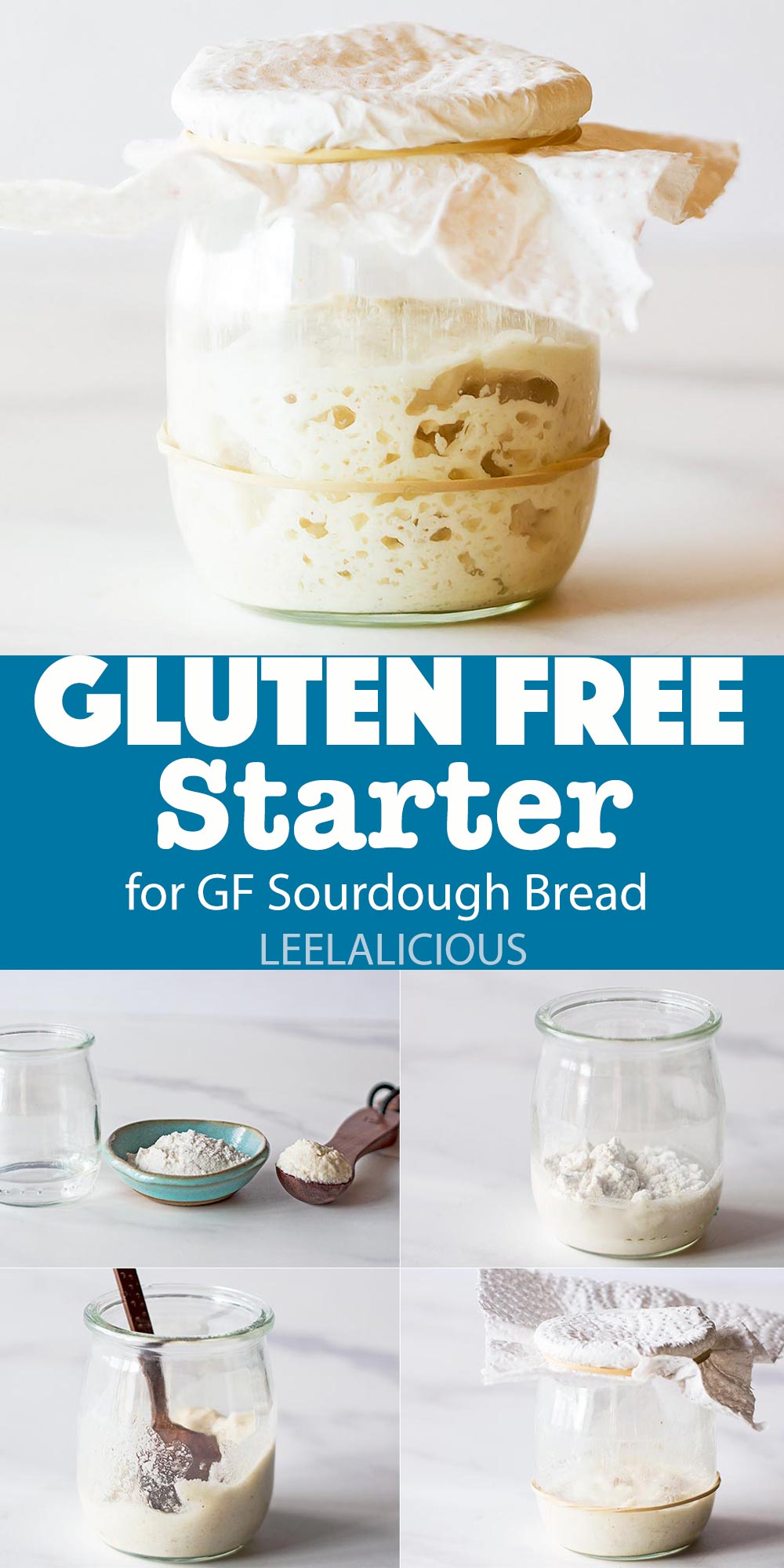
Random Questions
Yes, traditional sourdough starter can be converted to gluten-free by using a gluten-free flour blend instead of wheat-based flour.
Absolutely. Gluten-free sourdough uses a mixture of gluten-free flour and water, fostering wild yeast and bacteria, providing flavor and structure.
Feed your gluten-free sourdough starter daily for optimal activity. If not baking frequently, store it in the fridge and feed it weekly.
Yes, a gluten-free sourdough starter can be considered active and ready when it doubles in size within six hours or floats in water.


ND
Do you have a gluten-free and low-carb version? Thank you for sharing!
Jennifer @ Leelalicious
Hi ND, this is the only gluten-free starter on the site, but it is not low-carb.
Carolyn
The water measurement that you use for your recipe for gluten free sourdough bread doesn't seem right. Mine does not look like yours, it's more flour than water and flour. Please give me measurements in usa and not grams.
Regina | Leelalicious
Hey Carolyn, are you asking about the starter or the bread recipe? How is yours different? Too dry or too liquid? You can always adjust a little as needed. Variables like different gf flour blend or humidity in your area can affect bread dough.
Also, both the starter and the sourdough bread recipe include metric and imperial measurements. Be sure to toggle between the 2 at the bottom of the ingredient list.